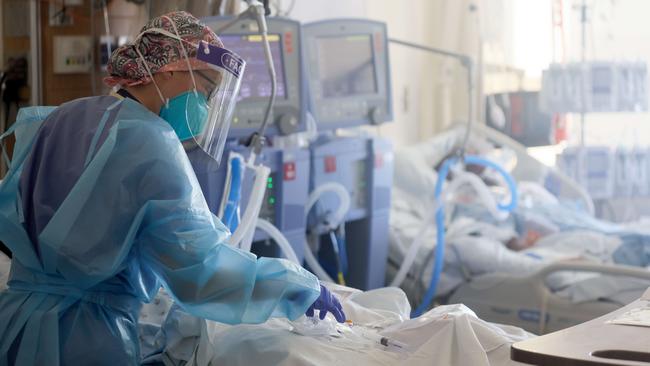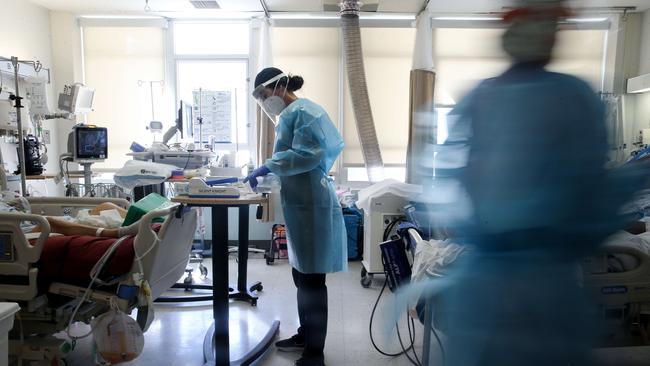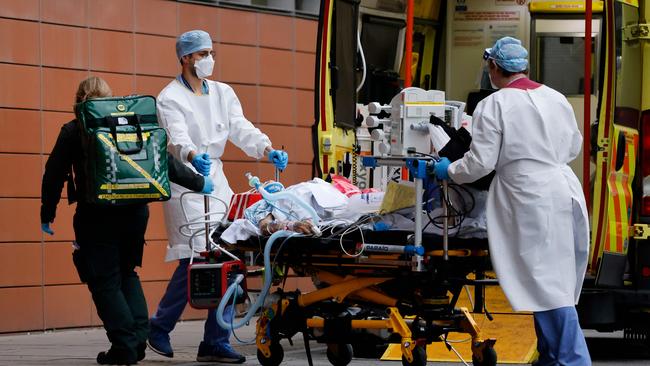Covid a deadly new foe in the battle for hearts and lungs
With millions of infected organs, the pandemic is having a devastating impact on transplant operations.

In her small cluttered office in Harefield Hospital, northwest London, consultant cardiologist Dr Shelley Rahman Haley kicks some astonishingly high-heeled green shoes out of the way and pulls out a beautifully handwritten letter, all the time talking 19 to the dozen.
It is from an 85-year-old woman and is thanking her adeadly new foe in the battle for hearts and lungs and her colleague, cardiac surgeon Mario Petrou, for “giving her back” her son Graeme Tucker through recent open-heart surgery to replace his mitral valve.
Tucker, 54, jogged a mile last week for the first time in six years – only four months after taking what he thought was his final selfie with his wife and two young children at home in Somerset.
The letter is a powerful reminder that even in the midst of a pandemic that has pushed the UK’s NHS to breaking point and hospitals to the fullest they have been, lifesaving operations go on, thanks to the incredible dedication of staff.
Last week Harefield carried out three lung transplants in three days, each taking four to five hours, and it has done more than 100 heart operations since Christmas. It has 10 patients who have been in hospital as long as 10 months waiting for heart transplants, most of that time with no visitors allowed.
All while the sickest of the sick, many of them alarmingly young, lie comatose in a specially repurposed COVID-19 intensive care unit, plasters over their eyes and an array of tubes and wires pumping blood, oxygen and fluids in and out. One man in his forties was about to have his end-of-life visit from his wife and young children – the only time families enter.
“It’s trying to keep all plates spinning in the air at once,” said site director Derval Russell, who has been working seven days a week since the first surge. This time, she says, it is much harder juggling beds – as hospitals around the capital call to send their most desperately ill Covid patients – while keeping up as a leading UK heart and lung transplant centre. All this with everyone exhausted, having gone from the first wave to catching up on a backlog of heart and lung operations, to the second wave, with all leave cancelled.
The new variant – and more testing picking up asymptomatic cases – has resulted in as many as a fifth of staff either off with Covid or isolating. “More and more staff are off with Covid this time,” Russell said. “I think I have the night shift sorted then within a couple of phone calls I have to start again.”
Though Harefield may still look like the old TB hospital it once was, it carries out some of the world’s most advanced surgery, including more than 3,000 transplants since Professor Sir Magdi Yacoub performed the first double heart and lung transplant in 1983.
Dealing with Covid has forced it to innovate as never before. Spending two humbling days there last week, I found a sense of adrenaline and esprit de corps more common to field hospitals in war – only this time the enemy is a microscopic virus with a crown of club-shaped spikes.

Medical advancement has often been driven by war. The Thomas splints rolled out across battlefields in the First World War reduced deaths from fractures from 80 per cent to 20 per cent. Ultrasound’s development allowed it to check cracks in tanks in the Second World War and it is now a key diagnostic tool. More recently the wars in Afghanistan and Iraq have greatly improved prosthetics for amputees and survival from gunshot wounds.
When I meet Rahman Haley, 49, and Petrou, 56, they have just finished a virtual meeting with about 30 heart surgeons from hospitals across London, discussing cases as they now do every morning. “Patients are not just getting a second opinion but maybe 20-plus, which is incredible,” said Petrou.
“And bear in mind, cardiac surgeons are damn competitive yet now suddenly working as a team,” said Rahman Haley, laughing.
“Emergency situations often bring out the best in people and that’s certainly been the case at Harefield,” said Nick Hunt, a hospital director. “Initiatives we’d talked about for years have materialised in weeks. Even with the incredible demands on staff and capacity, we’ve somehow introduced digital outpatient clinics, home testing, webcam support in ICUs [intensive care units], and new ways of collaborating remotely with other hospitals that effectively give patients access to expert opinion from multiple sources. The speed at which these solutions were found was remarkable. We have literally transformed the clinical landscape.”
But, he admits, the challenges are enormous. While the nation is fixated on daily death figures, which last week were the world’s highest per capita, the knock-on effects of Covid include a massive drop in lungs available for transplant – numbers have fallen by half, according to Hunt – and a huge backlog in surgery.
Delays in heart patients coming to hospital have caused such deterioration that surgeons are having to relearn from medical school how to deal with dangerous conditions such as holes and ruptures they have not seen for years.
“In 20 years as a cardiologist I’d seen a papillary rupture once or twice,” said Dr Robert Smith, who runs the hospital’s heart attack centre. “In the past nine months I’ve seen six, and mortality for that is eight in 10.”
Unlike at other hospitals, heart surgery did not stop but was very limited – only those in imminent danger – but also because people feared coming in, or when they did, they may have sat at home for days so were much more serious.
“People definitely died unnecessarily of heart attacks – and that’s sad,” said Smith. “Cardiovascular disease is still the most common cause of death, but if people come to hospital we will have them within 25 minutes on the table with their arteries open and putting in stents to save them.”
Despite great efforts to catch up over the summer, more and more are having lifesaving surgery delayed. “What we have now is more serious cases and more limited resources,” said Rahman Haley. “It has gone from a cloud to a storm.”

The Harefield and its sister hospital, the Royal Brompton, now have 450 patients on their waiting list with progressive cardiac disease. “Many were put on a year ago and their condition has deteriorated, and are now at risk of sudden death,” said Petrou. “At the same time we have to manage Covid patients so have to adopt a ‘utilitarian approach’.”
“These are really difficult decisions,” said Rahman Haley. “If you have two patients of similar age both in their forties with similar symptoms, how on earth do you choose?”
In the transplant centre, Dr Anna Reed is relieved to have got three lung transplants out of the way, with all three doing well. “That feels a huge achievement in the current climate,” said Reed.
“It can be very rewarding as you take a person who can’t even brush their teeth who then ends up climbing Sydney Harbour Bridge. It’s amazing what we can do, but the downside is it’s for a finite number of people for a finite number of years.”
The hospital’s longest-surviving transplant patient lasted 32 years – and died of something unrelated – but lungs are particularly susceptible to rejection and only half of the patients will still be alive after five years.
Normally, the hospital performs 40 or 50 lung transplants a year, and between 25 and 30 heart transplants, but this, she says, was significantly down over the past year – just 24 lung transplants and 23 hearts.
Covid does not just take up bed space, but also organs – they cannot use those from anyone who was infected.
“This means we are only transplanting people who are actively deteriorating,” said Reed. “If someone needs a heart or lung but is stable, we’ve had to make the really difficult decision to keep them off the list.”
As for the 10 patients still waiting for hearts who cannot go home because they need intravenous infusions, she said: “It’s not easy. I’ve had families standing outside the windows waving.”
But Reed fears for the future. “Covid will have an immensely long tail,” she warned. “At the moment we’re just focusing on mortality from the disease, but we are seeing numbers of people with post-Covid fibrosis so will eventually need lung transplants.”
So with fewer lungs available for transplant, more will need them. As with everything about this virus, she said, it is hard to predict who: “I saw one CT scan from the first wave where the lungs were almost solid and I thought this person will not survive. Six months later they were clear. Others that had the disease mildly have since deteriorated.”
She added: “It’s not just a lung problem. This is a multisystem disease, so people leaving ICU have problems with kidneys, pancreas, heart and confusion.”
That becomes clear when I put on the personal protective equipment (PPE) to enter the red zone of Covid intensive care. I feel like a blue Teletubby with my scrubs, gown, white Crocs, hairnet, and hood with visor and pipe attached to a machine strapped on to my back, and the only way to communicate is to shout. Nurses do 12 and a half-hour shifts like this.
Some people are on three life-support machines. All are on ventilators, but many are on ECMO – extracorporeal membrane oxygenation – machines that oxygenate the blood and take over the work of heart and lungs. Others have green-coloured kidney machines.
It is calm but very, very scary and, disturbingly, patients look neither old nor obese. The 25 patients are aged from 35 to 76, and four are female. The youngest the unit has lost was just 22.
“This time patients are younger and fitter and take longer to get better – or not to,” said Dr Ian McGovern, 51, the critical care consultant showing me round. “This time most of the ECMO patients are in their thirties and forties, even twenties and not particularly overweight,” said his colleague Dr Alex Rosenberg. “They are not diabetic, not high blood pressure. They could be us.”
The new variant is also clearly more infectious. This time round, far more staff are catching it even though they have better PPE. Alarmingly, almost everyone I interview seems to have had it in the past few weeks.
It feels like being in some awful dystopian world, and I know that having seen it I will never forget it. The stress on staff dealing with this every day, combined with the relentless pressure of 11 months, is a recipe for many tears, and the hospital now has an in-house psychologist for its staff.
“As ITU nurses we’re used to dealing with the sad part, but never on this scale,” said Mima Churchill, 34, who had the disease herself this month.

While I am on the unit, Churchill is preparing for a visit for one of her patients, a man in his forties who had been on the machines for a month but was not improving.
“It was awful,” she told me the next day. “His kids came, they were saying goodbye and were young – he was young and fit, and it seemed so unfair. I have two young kids and seeing his kids telling him what they had been doing that day and saying, ‘Daddy, please be OK,’ breaks my heart.
“It seems so unfair you can’t even hug them or give them tea and the PPE makes you feel heartless – like they are being comforted by a Dalek.”
That is not all. “You have a rubbish day like that then go to the shop and see people not wearing masks or distancing and think, ‘They just don’t get it,’” she said. “It’s so selfish. You might be safe, but you wouldn’t knowingly walk up to someone and give them a deadly disease – yet that’s what you’re doing.”

To join the conversation, please log in. Don't have an account? Register
Join the conversation, you are commenting as Logout